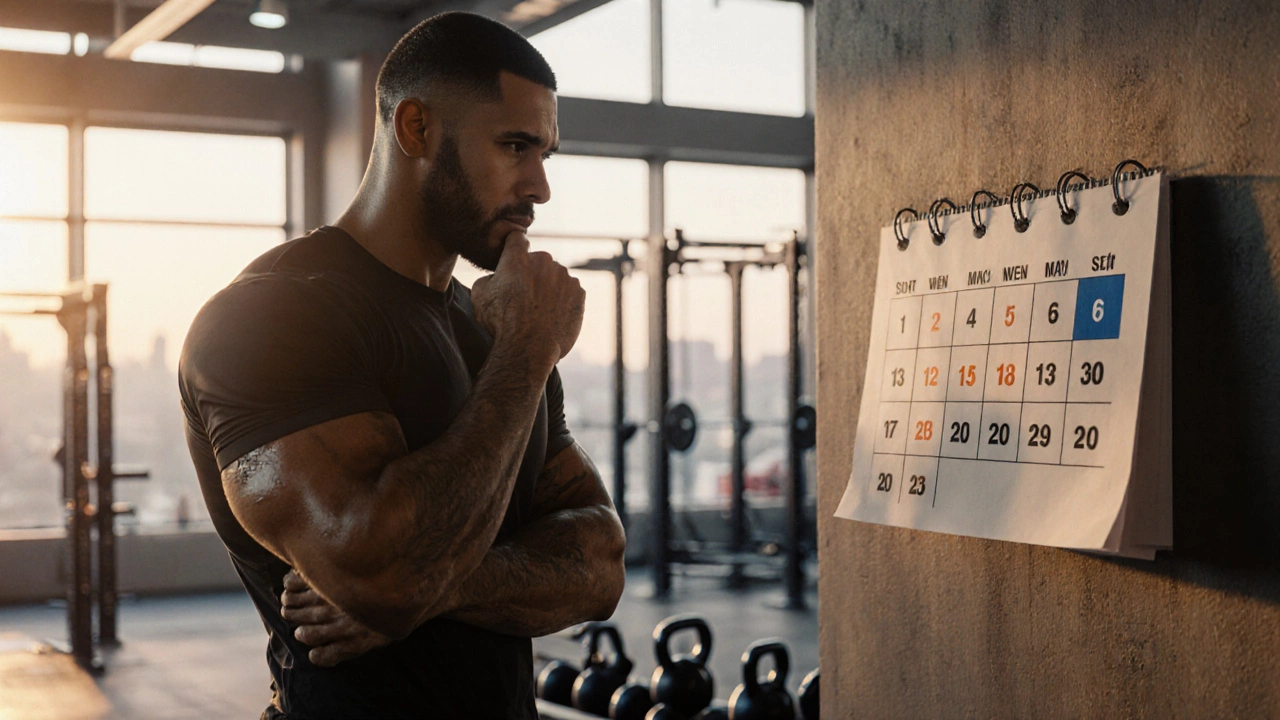Are Two Consecutive Rest Days Harmful for Strength Training?

Rest Day Decision Calculator
This tool helps determine if taking two consecutive rest days would be beneficial for your strength training program based on your current training frequency, fatigue levels, and progress.
When you’re grinding through a strength‑training program, the question of how many days off you should take feels as personal as your favorite workout split. Some lifters swear by back‑to‑back rest days while others claim any break longer than a single day stalls progress. This article untangles the science, highlights the situations where two days off in a row might actually set you back, and gives you a clear roadmap for planning recovery that fuels growth.
What Exactly Is a Rest Day?
Rest days are calendar days on which you deliberately avoid heavy resistance work, allowing your body to repair and adapt. In practice, a rest day can range from complete inactivity (laying on the couch) to light active recovery like walking or mobility drills. The key is that the central nervous system (CNS) and muscular tissue are not subjected to the high mechanical loads typical of a strength session.
Why Strength Training Needs Recovery
Strength training creates microscopic damage to muscle fibers, depletes glycogen stores, and triggers a cascade of hormonal responses. After the workout, your body initiates muscle protein synthesis (MPS), rewires neural pathways, and refills energy reserves. Without sufficient downtime, these processes compete with each other, leading to diminished returns.
Two pillars drive recovery:
- Muscle protein synthesis ramps up for roughly 24‑48 hours after a heavy lift, rebuilding fibers stronger than before.
- Hormonal response (including growth hormone, testosterone, and cortisol) fluctuates post‑exercise. Optimal balance fosters growth, while chronic cortisol elevation hinders it.
Two Rest Days in a Row: The Pros
When used strategically, a double rest day can be a powerful tool:
- Enhanced CNS recovery: Heavy compound lifts tax the nervous system heavily. A 48‑hour pause lets motor units fire more efficiently on the next session.
- Reduced injury risk: Fatigue accumulates over consecutive training days. Giving muscles and joints a breather lowers the odds of strain or overuse.
- Better sleep quality: A non‑training night often translates to deeper, more restorative sleep, which directly supports MPS.
For beginners or anyone new to a program, these advantages usually outweigh any perceived “loss of momentum”.

When Two Consecutive Rest Days Might Be Detrimental
The flip side appears for athletes who train at a high frequency (4‑6 sessions per week) and rely on consistent stimulus to keep adaptations ticking. In those cases, two days off can cause:
- Training frequency dip: If you normally train five days a week, dropping to three can reduce weekly volume enough to stall strength gains.
- Muscle protein synthesis window closure: MPS peaks around 24‑48 hours post‑workout and then tapers. Skipping the third day may miss the tail end of this anabolic window.
- Psychological momentum loss: Habit formation thrives on regularity. Long gaps can make it harder to get back into the groove.
These downsides are most pronounced for advanced lifters who already have a finely tuned program and rely on “micro‑loading” -‑ small, frequent increments of weight.
How to Decide If Two Rest Days Are Right for You
Ask yourself these four practical questions after each training week:
- Did I feel unusually fatigued or notice a drop in performance during the last session?
- Is my sleep quality compromised (less than 7 hours, frequent awakenings)?
- Have my nutrition and hydration been on point, especially protein intake (≈1.6‑2.2 g/kg body weight)?
- Am I tracking progress consistently (e.g., a 2‑5 % weekly strength increase) or have I plateaued for three weeks?
If you answer “yes” to two or more, a pair of rest days can act like a built‑in deload. If you’re consistently hitting your targets and feeling fresh, you might keep the rest to a single day.
Designing a Balanced Week With or Without Two Rest Days
Below is a sample 5‑day split that incorporates a strategic two‑day break for intermediate lifters. Feel free to shift the rest block to suit your schedule.
| Day | Focus | Key Lifts |
|---|---|---|
| Monday | Upper Body Push | Bench Press, Overhead Press |
| Tuesday | Lower Body | Squat, Romanian Deadlift |
| Wednesday | Rest / Light Mobility | - |
| Thursday | Upper Body Pull | Pull‑up, Barbell Row |
| Friday | Full‑Body Power | Deadlift, Power Clean |
| Saturday | Rest (Second Consecutive Day) | - |
| Sunday | Active Recovery (optional) | Walking, Stretching |
Notice how the double‑rest block follows the most demanding lift of the week (Friday’s deadlift). This timing lets the CNS fully recover before you start the next micro‑cycle.

Common Mistakes Around Rest Days
Even seasoned athletes slip up:
- Using rest days for “hard cardio”. Long, high‑intensity cardio can still tax the CNS and deplete glycogen, negating the recovery purpose.
- Skipping protein on rest days. Muscle repair needs amino acids round‑the‑clock; keep protein intake steady (20‑30 g per meal).
- Going “all‑out” with junk food. Poor nutrition spikes insulin and impairs hormonal balance, slowing recovery.
- Ignoring sleep hygiene. Without quality sleep, cortisol stays elevated and MPS is blunted.
Address these pitfalls and your rest days will truly become growth catalysts.
Monitoring Recovery: Simple Tools You Can Use
Three quick metrics give you a reality check:
- Heart‑rate variability (HRV): A drop of >10 % from baseline often signals insufficient recovery.
- Rate of perceived exertion (RPE) on the first set of your next workout. If you’re consistently above 8, consider adding a rest day.
- Training log consistency: Track sets, reps, and weight. A stagnating log for three weeks suggests you need extra rest.
These tools let you move from guesswork to data‑driven programming.
Bottom Line: Two Rest Days Aren’t Inherently Bad-It’s All About Context
In short, rest days are the lifeblood of any strength‑training plan. Two consecutive days can accelerate recovery, protect against injury, and improve performance-provided they fit your training frequency, experience level, and personal recovery rate. Use the questions, metrics, and sample schedule above to decide whether the double‑rest fits your goals.
Will taking two rest days in a row make me lose strength?
Not if the rest aligns with your overall training volume and frequency. Strength is maintained when weekly load stays consistent; a planned two‑day break can even improve subsequent lifts by allowing full CNS recovery.
How many rest days should a beginner take?
Beginners typically benefit from at least one full rest day after every 2‑3 training sessions. Two consecutive days are fine if the program calls for three‑plus sessions per week, but they’re rarely necessary.
Can I do light cardio on a rest day?
Yes, as long as the cardio is low‑intensity (e.g., 20‑30 minutes of walking or easy cycling). High‑intensity intervals still stress the nervous system and may counteract recovery.
What’s the best way to track if I need extra rest?
Combine subjective measures (energy levels, mood) with objective data like HRV, RPE, and weekly training logs. Consistent declines signal the need for additional rest.
Is a “deload week” the same as taking two rest days?
A deload week reduces load across the entire training cycle (often 40‑60 % of normal intensity), whereas two rest days are simply calendar days without heavy lifting. Both aim to recover, but deloads address cumulative fatigue over longer periods.